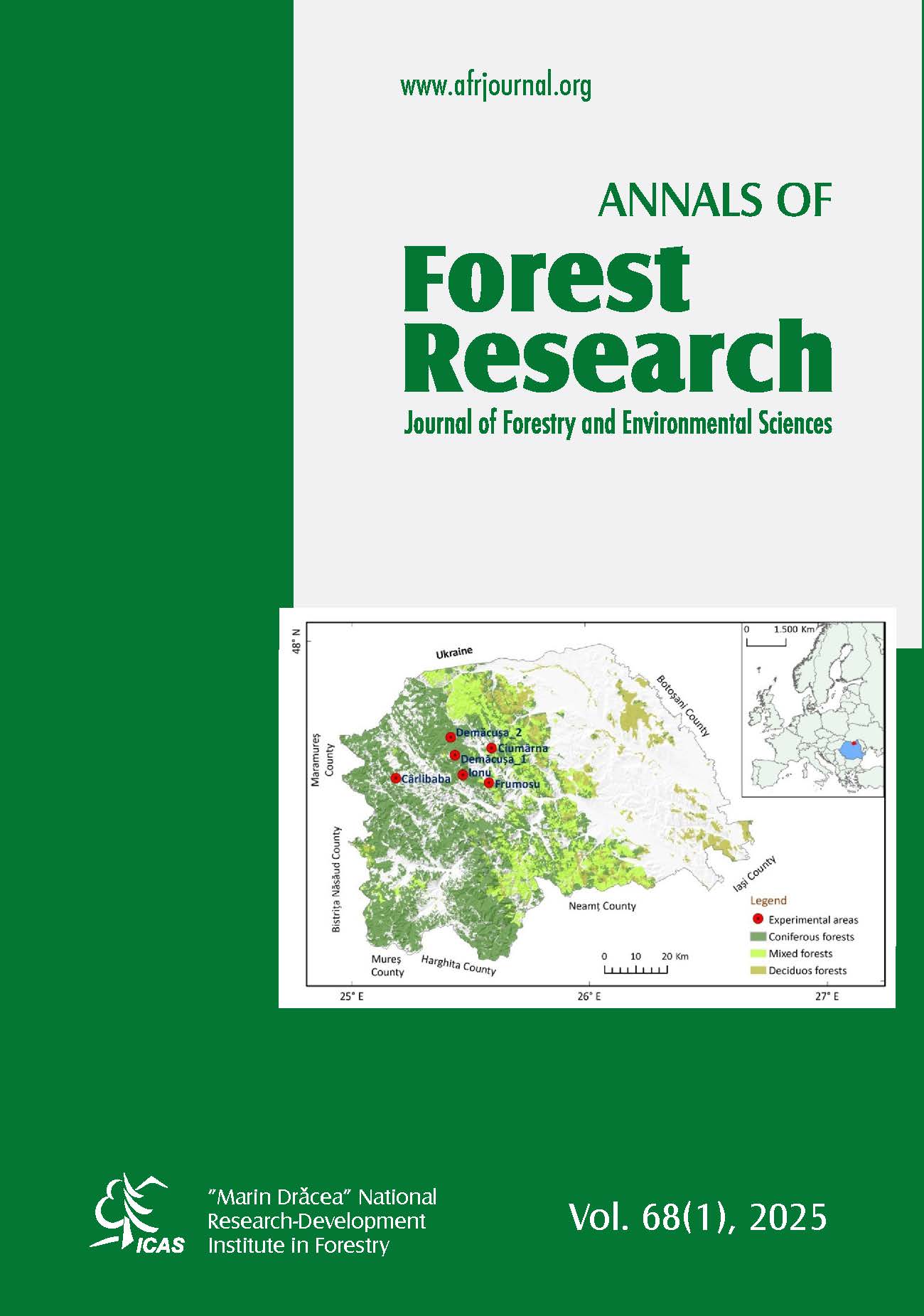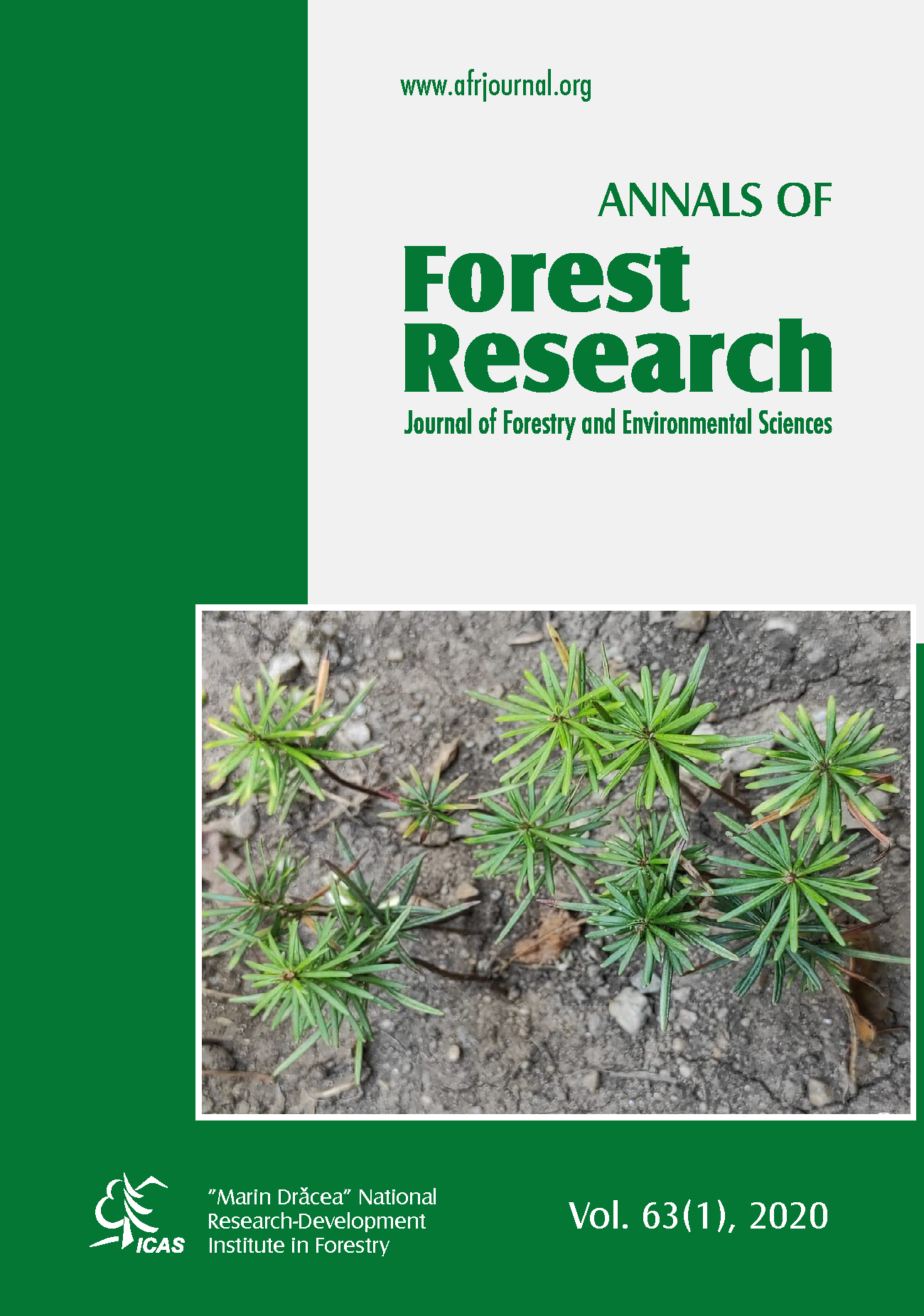Tree stem mean diameter reduction factor prediction through advanced modeling approaches
DOI:
https://doi.org/10.15287/afr.2025.3433Keywords:
mean diameter reduction factor, cascade correlation, generalized regression, Bayesian regularization, support vector regressionAbstract
Sustainable management of natural resources relies on accurate modelling of forest attributes to prevent degradation. This study explores advanced modelling techniques, including Artificial Neural Networks (ANN) and Support Vector Regression (SVR), for estimating the mean stem diameter reduction factor (taper) of standing fir trees (Abies x borisii-regis Matff.). These methods are compared against traditional non-linear regression model (NLR), developed using the Levenberg-Marquardt optimization algorithm. The ANN models employ cascade correlation, generalized regression, and Bayesian regularization back-propagation architectures, while the ε-SVR approach is assessed for its robustness. The results show that support vector regression (ε-SVR) achieved the lowest relative errors in model fitting, improving by 0.60% over cascade correlation and generalized regression and by 0.67% over Bayesian regularization. Regarding generalization ability, the ε-SVR model performed best, with a relative error of 4.90%, which was slightly lower than cascade correlation (by 0.1%), generalized regression (by 0.01%), and Bayesian regularization (by 0.04%). A comparative analysis between machine learning approaches and standard regression revealed that the ε-SVR model had the lowest mean error (0.0715), while the non-linear regression (NLR) model showed a higher mean error of 0.0955, which means 1.35 times greater. These findings highlight the strong capability of machine learning methods in accurately estimating and predicting the diameter reduction factor of trees, effectively capturing its non-linear behaviour compared to traditional regression models. Overall, this study underscores the potential of advanced machine learning techniques to enhance accuracy and adaptability in sustainable forest management.
References
Belete D.M., Huchaiah M.D., 2022. Grid search in hyperparameter optimization of machine learning models for prediction of HIV/AIDS test results. International Journal of Computers and Applications 44(9): 875-886. https://doi.org/10.1080/1206212X.2021.1974663.
Boser B., Guyon I., Vapnik V., 1992. A training algorithm for optimal margin classifiers. In: COLT '92, ACM Publications, Fifth annual workshop on Computational learning theory. Pittsburgh, Pennsylvania, USA, pp. 144–152. https://doi.org/10.1145/130385.130401.
Burden F., Winkler D., 2008. Bayesian Regularization of Neural Networks. In: Livingstone, D.J. (eds), Humana Press, Artificial Neural Networks. Methods in Molecular Biologyâ"¢, vol 458. https://doi.org/10.1007/978-1-60327-101-1_3.
Diamantopoulou M.J., 2005. Predicting fir trees stem diameters using Artificial Neural Network models. Southern African Forestry Journal 205(1): 39-44. https://doi.org/10.2989/10295920509505236.
Diamantopoulou M.J., 2022. Simulation of over-bark tree bole diameters, through the RFr (Random Forest Regression) algorithm. Folia Oecologica 49(2): 93-101. https://doi.org/10.2478/foecol-2022-0010 .
Diamantopoulou M.J., Özçelik R., Yavuz H., 2018. Tree-bark volume prediction via machine learning: A case study based on black alder's tree-bark production. Computers and Electronics in Agriculture 151: 431-440. https://doi.org/10.1016/j.compag.2018.06.039.
Draper N.R., Smith H., 1998. Applied regression analysis, third ed., Wiley, NY, 716 p. https://doi.org/10.1002/9781118625590.
Efron B., Tibshirani R.J., 1994. An introduction to the bootstrap. Chapman & Hall/CRC, NY, 456 p. https://doi.org/10.1201/9780429246593.
Ercanlı İ., 2020. Innovative deep learning artificial intelligence applications for predicting relationships between individual tree height and diameter at breast height. Forest Ecosystems 7: 1-18. https://doi.org/10.1186/s40663-020-00226-3.
Fahlman S.E., Lebiere C., 1990. The cascade correlation learning architecture. In D.S. Touretsky (ed.), Advances in Neural Information Processing Systems 2, Morgan Kaufmann, San Mateo, CA, pp. 524-532.
Gurney K., 1997. An introduction to neural networks. CRC Press, UK, pp. 234. https://doi.org/10.1201/9781315273570.
Heidarlou H.B., Shafiei A.B., Tayyebi A., Borz S.A., 2023. Evaluating the effect of ongoing conservation policies and forest cover changes in Iranian Zagros forests based on a Land Transformation Model: transition to forest or deforestation? Annals of Forest Research 66(1): 79-97. https://doi.org/10.15287/afr.2023.2628.
Hirigoyen A., Acosta-Muñoz C., Salamanca A.J.A., Varo-Martinez M.A., Rachid-Casnati C., Franco J., Navarro-Cerrillo R., 2021. A machine learning approach to model leaf area index in Eucalyptus plantations using high-resolution satellite imagery and airborne laser scanner data. Annals of Forest Research 64(2): 165-183. https://doi.org/10.15287/afr.2021.2073.
Hoaglin D.C., Mosteller F., Tukey J.W., 2006. Exploring data tables, trends and shapes. Wiley-Interscience, NY, 576 p.
IBM-SPSS 2021. IBM Corp. Released 2021. IBM SPSS Statistics for Windows, Version 29.0. IBM Corp, Armonk, NY.
Jiao Y., Zhao l., Deng O., Weihend X., Feng Z., 2013. Calculation of live tree timber volume based on particle swarm optimization and support vector regression. Transactions of the Chinese Society of Agricultural Engineering (Transactions of the CSAE) 29(20): 160-167. https://doi.org/10.3969/j.issn.1002-6819.2013.20.022.
Kalkanlı Genç S., Diamantopoulou M.J., Özçelik R., 2023. Tree Biomass Modeling Based on the Exploration of Regression and Artificial Neural Networks Approaches. Forests 14: 2429. https://doi.org/10.3390/f14122429.
Kayri M., 2016. Predictive Abilities of Bayesian Regularization and Levenberg–Marquardt Algorithms in Artificial Neural Networks: A Comparative Empirical Study on Social Data. Mathematical and Computational Applications 21(2): 20. https://doi.org/10.3390/mca21020020.
Levenberg K., 1944. A method for the solution of certain non-linear problems in least squares. Quarterly of Applied Mathematics 2: 164-168. https://doi.org/10.1090/qam/10666.
Lilliefors H.W., 1967. On the Kolmogorov-Smirnov Test for Normality with Mean and Variance Unknown. Journal of the American Statistical Association 62(318): 399-402. https://doi.org/10.2307/2283970.
Malek S., Miglietta F., Gobakken T., Næsset E., Gianelle D., Dalponte M., 2019. Prediction of stem diameter and biomass at individual tree crown level with advanced machine learning techniques iForest-Biogeosciences and Forestry 12(3): 323-329. https://doi.org/10.3832/ifor2980-012.
Marquardt D.W., 1963. An algorithm for least-squares estimation of nonlinear parameters. Journal of the society for Industrial and Applied Mathematics 11(2): 431- 441. http://www.jstor.org/sTab./2098941.
Matis K.G., 2004. Forest Biometry II. Dendrometry, Pigasos Press, Thessaloniki, Greece. [In Greek].
Matlab 2022. MATLAB version 19.12.0, release name 2022a, num. 47. The MathWorks Inc., Natick, Massachusetts, available: https://www.mathworks.com/help/stats/index.html.
Monnet J.M., Chanussot J., Berger F., 2011. Support vector regression for the estimation of forest sand parameters using airborne laser scanning. IEEE Geoscience and Remote Sensing Letters 8(3): 580-584. https://doi.org/10.1109/LGRS.2010.2094179.
Montesinos López O.A., Montesinos López A., Crossa J., 2022. Support Vector Machines and Support Vector Regression. In: Multivariate Statistical Machine Learning Methods for Genomic Prediction. Springer, Cham. https://doi.org/10.1007/978-3-030-89010-0_9.
Moradi F., Sadeghi S.M.M., Heidarlou H.B., Deljouei A., Boshkar E., Borz S.A., 2022. Above-ground biomass estimation in a Mediterranean sparse coppice oak forest using Sentinel-2 data. Annals of Forest Research 65(1): 165-182. https://doi.org/10.15287/afr.2022.2390.
Myatt G.J., Johnson W.P., 2014. Making Sense of Data I. A Practical Guide to Exploratory Data Analysis and Data Mining. 2nd ed., John Wiley & Sons, Inc. New Jersey, 231p.
Nocedal J., Wright S.J., 2006. Numerical Optimization. 2nd ed., Springer Series in Operations Research and Financial Engineering, Springer-Verlag NY, 664p. https://doi.org/10.1007/978-0-387-40065-5.
Özçelık R., Diamantopoulou M.J., Eker M., Gürlevık N., 2017. Artificial neural network models: an alternative approach for reliable aboveground pine tree biomass prediction. Forest Science 63: 291-302. https://doi.org/10.5849/FS-16-006.
Özçelık R., Diamantopoulou M.J., Trincado G., 2019. Evaluation of potential modeling approaches for Scots pine stem diameter prediction in north-eastern Turkey Computers and Electronics in Agriculture 162: 773-782. https://doi.org/10.1016/j.compag.2019.05.033.
Patterson D., 1996. Artificial neural networks. Prentice Hall, Singapore, 477p.
Python Software Foundation 2022. © Copyright 2001-22, https://docs.python.org/3.9/index.html.
Russell S., Norvig P., 2020. Artificial Intelligence: A Modern Approach (Pearson Series in Artificial Intelligence), 4th ed., Pearson, 1136 p. https://books.google.gr/books?id=koFptAEACAAJ.
Sandoval S., Acuña E., 2022. Stem taper estimation using artificial neural networks for Nothofagus trees in natural forest. Forests 13: 2143. https://doi.org/10.3390/f13122143.
Sariev E., Germano G., 2020. Bayesian regularized artificial neural networks for the estimation of the probability of default. Quantitative finance, 20(2): 311-328. https://doi.org/10.1080/14697688.2019.1633014
Shaw D.J., Meldahl R.S., Kush J.S., Somers G.L., 2003. A tree taper model based on similar triangles and the use of crown ratio as a measure of form in taper equations for longleaf pine. Gen. Tech. Rep. SRS-66. Asheville, NC: U.S. Department of Agriculture, Forest Service, Southern Research Station. 8 p.
Smola A.J., Schölkopf B., 2004. A tutorial on support vector regression. Statistics and Computing 14: 199–222. https://doi.org/10.1023/B:STCO.0000035301.49549.88
Speckt D.F., 1991. A General Regression Neural Network. IEEE Transactions on Neural Networks, 2(6): 568-576. https://doi.org/10.1109/72.97934
Swingler K., 1996. Applying Neural Networks: A Practical Guide. 1st ed., Morgan Kaufmann, 303p.
Titterington D.M., 2004. Bayesian Methods for Neural Networks and Related Models. Statistical Science 19: 128-139. https://doi.org/10.1214/088342304000000099
Thomas S., Pillai G.N., Pal K., 2017. Prediction of peak ground acceleration using ϵ-SVR, ν-SVR and Ls-SVR algorithm. Geomatics, Natural Hazards and Risk 8(2): 177-193. https://doi.org/10.1080/19475705.2016.1176604
Vapnik V., 1999. Three remarks on the support vector method of function estimation. In: Schölkopf B., Burges C.J.C., Smola A.J. (eds.), Advances in Kernel Methods—Support Vector Learning, MIT Press, Cambridge, MA, pp. 25–42.
Vapnik V., 2000. The nature of statistical learning theory. 2nd ed. Springer, New York, pp 314. https://doi.org/10.1007/978-1-4757-3264-1.
Vapnik V., Golowich S., Smola A., 1997. Support Vector Method for Function Approximation, Regression Estimation, and Signal Processing. In Mozer M., Jordan M., Petsche T. (eds.), Neural Information Processing Systems, Vol. 9. MIT Press, Cambridge, MA.
Vieira G.C., de Mendonça A.R., da Silva G.F., Zanetti S.S., da Silva M.M., Dos Santos A.R., 2018. Prognoses of diameter and height of trees of eucalyptus using artificial intelligence. Science of the Total Environment 619: 1473-1481. https://doi.org/10.1016/j.scitotenv.2017.11.138
Wang D., Wang M., Qiao X., 2009. Support vector machines regression and modeling of greenhouse environment. Computers and Electronics in Agriculture 66(1): 46-52. https://doi.org/10.1016/j.compag.2008.12.004
West P.W., 2015. Tree and Forest Measurement. 3rd ed, Springer, Cham, pp 214. https://doi.org/10.1007/978-3-319-14708-6
Williams G., 2011. Data Mining with Rattle and R: The Art of Excavating Data for Knowledge Discovery, use R. Springer Science+Business Media, LLC. https://doi.org/10.1007/9781441998-2
Zhou R., Wu D., Zhou R., Fang L., Zheng X., Lou X., 2019. Estimation of DBH at forest stand level based on multi-parameters and generalized regression neural network. Forests 10: 778. https://doi.org/10.3390/f10090778
Zuur A.F., Ieno E.N., Elphick C.S., 2010. A protocol for data exploration to avoid common statistical problems. Methods in Ecology and Evolution 1: 3–14. https://doi.org/10.1111/j.2041-210X.2009.00001.x
Downloads
Published
Issue
Section
License
All the papers published in Annals of Forest Research are available under an open access policy (Gratis Gold Open Access Licence), which guaranty the free (of taxes) and unlimited access, for anyone, to entire content of the all published articles. The users are free to "read, copy, distribute, print, search or refers to the full text of these articles", as long they mention the source.
The other materials (texts, images, graphical elements presented on the Website) are protected by copyright.
The journal exerts a permanent quality check, based on an established protocol for publishing the manuscripts. The potential article to be published are evaluated (peer-review) by members of the Editorial Board or other collaborators with competences on the paper topics. The publishing of manuscript is free of charge, all the costs being supported by Forest Research and Management Institute.
More details about Open Access:
Wikipedia: http://en.wikipedia.org/wiki/Open_access






